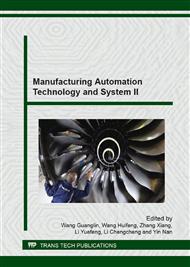p.3
p.9
p.19
p.25
p.32
p.38
p.44
p.51
Static Stiffness Optimization of Large Ram Based on Equivalent Elastic Modulus
Abstract:
The finite element model of heavy-duty machine tool’s ram components has a large number of elements, many contact pairs for assembly and a large-scale optimization calculation, which make the optimization difficult to conduct. To solve this problem, a static stiffness optimization method of the large component based on the equivalent elastic modulus is put forward. The proposed method is applied to super-heavy-duty CNC floor-type milling and boring machine of TK6932 as a case study. Based on the principle of the equivalent stiffness, the ram assembly with complex constraints and contacts is equivalent to a ram part without other components, the calculation method of the equivalent elastic modulus is analyzed and the equivalent elastic modulus formula of the ram under the bending load is derived. Taking the four box-walls’ thickness and the three stiffened-plates’ thickness of the ram as the optimization variables, the minimal volume under static loading as the target and the maximal displacement and stress as the constraints, the optimized mathematical model of the ram’s equivalent static stiffness is established. The results of the optimization are rounded according to the sensitivity analysis. Besides, the optimization effect is proved by simulation through the finite element technology. The optimization procedure and results show that the simplified method based on equivalent elastic modulus presented in the paper can control the calculation scale effectively, and ensure the process of the optimization smooth.
Info:
Periodical:
Pages:
9-18
Citation:
Online since:
August 2014
Authors:
Price:
Сopyright:
© 2014 Trans Tech Publications Ltd. All Rights Reserved
Share:
Citation:


